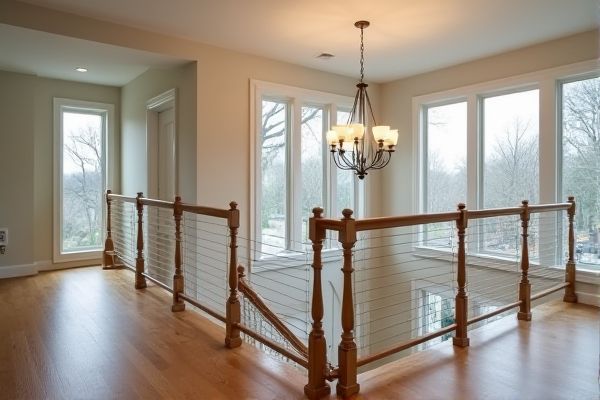
Cable railing offers a modern, minimalist look with horizontal stainless steel cables that provide an unobstructed view, while spindle railing features vertical balusters that emphasize traditional design and enhanced safety. Explore this article to determine which railing option best suits your style and functional needs.
Table of Comparison
| Feature | Cable Railing | Spindle Railing |
|---|---|---|
| Material | Stainless steel cables, metal posts | Wood or metal spindles |
| Appearance | Modern, sleek, minimalistic | Traditional, detailed, classic |
| Visibility | High visibility, unobstructed views | Lower visibility, more obstructed views |
| Maintenance | Low maintenance, occasional tightening | Moderate maintenance, painting or staining |
| Installation | Requires tensioning tools, professional recommended | Simple installation, DIY friendly |
| Durability | Highly durable, weather resistant | Depends on material, may require upkeep |
| Cost | Higher initial cost | Generally lower cost |
| Safety | Meets safety codes if tensioned properly | Traditionally safe and code compliant |
Introduction to Cable Railing and Spindle Railing
Cable railing features tensioned stainless steel cables that offer unobstructed views and a sleek modern look, ideal for outdoor decks and staircases. Spindle railing consists of evenly spaced vertical rods or balusters, typically made of wood, metal, or composite materials, providing classic safety and decorative appeal. Your choice between cable and spindle railing depends on whether you prioritize minimalistic transparency or traditional styling and structural patterns.
Design Aesthetics: Modern vs. Traditional
Cable railing offers a sleek, modern design aesthetic characterized by minimalistic lines and unobstructed views, enhancing contemporary outdoor spaces with a clean and airy feel. Spindle railing, with its vertical bars and classic patterns, evokes a traditional charm that complements historic or rustic home designs. Your choice between cable and spindle railing depends on whether you prefer the modern simplicity of cable or the timeless elegance of spindle for your outdoor railing.
Installation Process and Complexity
Cable railing installation involves threading stainless steel cables through pre-drilled posts, requiring tensioning tools and precise alignment to ensure safety and aesthetics. Spindle railing installation entails affixing evenly spaced balusters or spindles to top and bottom rails, generally simpler and more accessible for DIY projects due to standard sizing and fewer specialized tools. While cable systems demand careful cable tension adjustments and corrosion-resistant materials, spindle installations focus on carpentry skills and secure fastening techniques.
Material Options and Durability
Cable railing systems typically utilize stainless steel cables known for their high tensile strength and resistance to corrosion, making them ideal for outdoor use and long-term durability. Spindle railings, often made from wood, aluminum, or wrought iron, offer a variety of material options but may require more maintenance depending on the chosen material, such as regular painting or sealing for wood to prevent weather damage. Selecting between cable and spindle railing depends on your durability needs and material preferences, as cable railings offer superior longevity with minimal upkeep.
Safety and Building Code Compliance
Cable railing systems offer superior safety features by providing consistent tension and minimal gaps, reducing the risk of falls while meeting stringent building code requirements for residential and commercial properties. Spindle railings, while aesthetically traditional, often require precise spacing and regular maintenance to comply with safety standards mandated by local building codes. Ensure your railing choice aligns with your local code for maximum safety and durability.
Maintenance Requirements and Longevity
Cable railing requires minimal maintenance due to its stainless steel cables that resist rust and corrosion, ensuring long-lasting durability even in harsh weather conditions. Spindle railing, often made of wood or metal, demands regular upkeep such as painting, sealing, or rust prevention to maintain its appearance and structural integrity. You can expect cable railing to provide a more hassle-free, long-lasting solution compared to the higher maintenance needs of spindle railing.
Cost Comparison and Budget Considerations
Cable railing generally offers a more affordable option compared to spindle railing, with installation costs typically ranging from $35 to $60 per linear foot versus $50 to $100 per linear foot for spindle railing. Material expenses for cable railing are lower due to its minimalist design using stainless steel cables and fewer components, which reduces overall labor time and complexity. Budget considerations favor cable railing for projects aiming to balance modern aesthetics with cost-efficiency, while spindle railing may incur higher costs due to intricate designs and the use of wood or metal spindles.
View Preservation and Visual Impact
Cable railing offers superior view preservation with its thin, horizontal stainless steel cables that create minimal visual obstruction, enhancing your outdoor scenery. Spindle railing, featuring vertical bars, tends to interrupt sightlines more frequently and can create a heavier visual presence. Choosing cable railing significantly reduces visual impact, maintaining an open and unobstructed view of your surroundings.
Suitability for Indoor and Outdoor Spaces
Cable railing offers exceptional durability and corrosion resistance, making it ideal for both indoor staircases and outdoor decks exposed to weather elements. Spindle railing, often crafted from wood or metal, suits indoor spaces due to its traditional aesthetic but may require more maintenance when used outdoors. Both railing types complement modern and classic designs, with cable railing favored for minimalist, open views and spindle railing for enhanced privacy and decorative appeal.
Choosing the Right Railing System for Your Project
Cable railing offers a sleek, modern aesthetic and superior visibility, ideal for projects emphasizing unobstructed views and contemporary design. Spindle railing provides a classic, traditional look with stronger, closely spaced vertical supports, enhancing safety and complementing historic or rustic architecture. Your choice depends on balancing style preferences, safety requirements, and the architectural context of your project.
 homyna.com
homyna.com